Search Results for: the wall
Genre: Horror
Premise: An aging rocker with a hankering for death-themed items purchases an old suit online that is said to be haunted, as it comes with the ghost of the man it belonged to.
About: This is an early adaptation of one of Joe Hill’s books. With the recent success of Black Phone, there’s a good chance the book will be thrust back onto the Hollywood deal table. Joe Hill’s title was pulled from Nirvana’s song, “Heart-shaped Box.” Neil Jordan, who adapts today’s script, has won an Oscar for Best Original Screenplay (The Crying Game).
Writer: Neil Jordan (based on the book by Joe Hill)
Details: 129 pages – 2007 draft
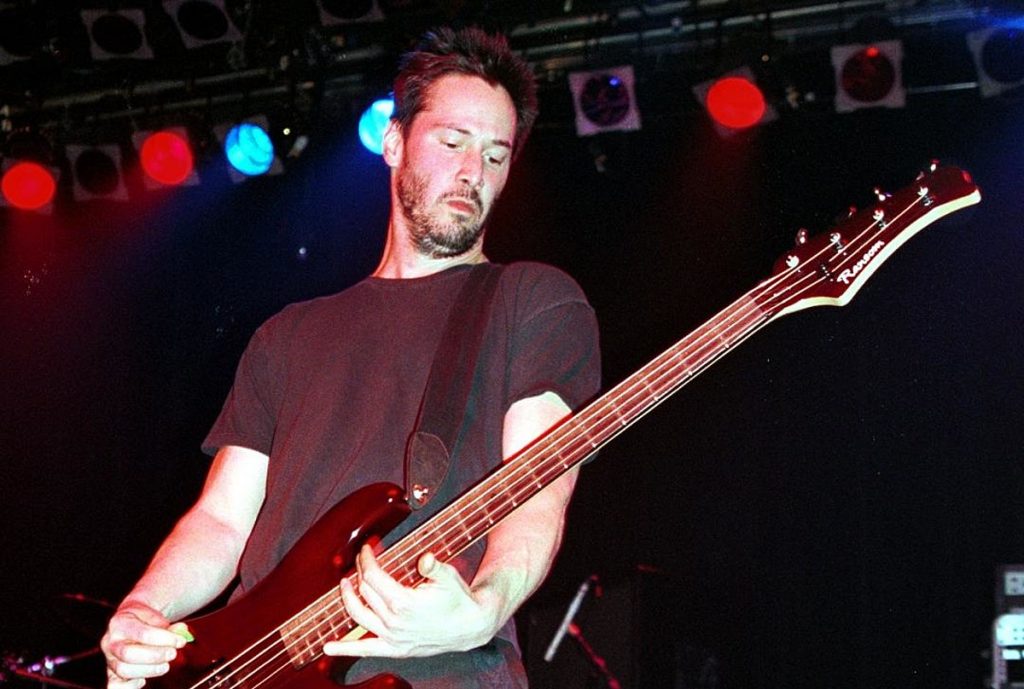 Keanu for Judas?
Keanu for Judas?
This might be the weirdest adaptation choice ever.
Neil “Crying Game” Jordan adapting Joe “Black Phone” Hill?
This feels like something Shay Hatten should be adapting. Isn’t he the Stephen King nut? (Joe Hill is King’s son, for those who don’t know)
I don’t know if I’d say that Neil Jordan feels “too good” for this, cause he hasn’t exactly been lighting up the movie marquee lately. But he definitely feels like an out-of-left-field choice. I’m not sure what to expect. But maybe that’s a good thing! Let’s find out.
Judas Coyne used to be a big time rocker in a “Megadeth” type band. These days, however, in his 50s, he’s spending a lot more time at home than on the road. It’s at his large mansion that he hangs out with his former-stripper girlfriend, Georgia. He calls her Georgia cause that’s where they met.
Judas loves to collect things like torture devices and skulls – anything that has to do with death. So when his assistant, Danny, spots a “haunted suit” online, Judas tells him to buy it. Several days later, the suit shows up (in a heart-shaped box), and Judas doesn’t even get to sleep that night before seeing James Craddock, the ghost of the man who owned the suit.
Judas soon learns that Craddock is here to kill him. More specifically, he’s going to make Judas commit a murder-suicide with Georgia. Freaked out, Judas and Georgia try and burn the suit. But that doesn’t do baloney. Craddock keeps showing up and taunting them.
Judas eventually learns that Craddock is the father of a groupie he once dated. When Judas ended the relationship, the groupie killed herself. Craddock is here for revenge. The only solution Judas can come up with is jumping in the car with Georgia, driving to Florida, and confronting the dead groupie’s sister, who tricked Judas into buying the suit.
Along the way, they stop at Georgia’s aunt’s place. Her aunt is a medium and, during a Ouija session, the dead groupie possesses Georgia. What we learn is that the cause of the suicide is a lot more complicated than originally thought. The sister may have been involved in it. So off Judas and Georgia go, this time with more purpose, to confront the sister, and get Craddock off their back for good.
I’m going to be honest – when I first saw Jordan’s name on this project, a little voice in the back of my head said, “Looks like someone needed to pay off the mortgage.” This had all the makings of a paycheck job.
And for a good 20-30 pages there, I felt like those fears were confirmed. You see, one of the biggest traps in horror is the “wait around for scares to happen” approach. This is where you put your hero in a house or a building or a barn or wherever, and they just wait for scary things to happen for 90 minutes. There is no activity. Only re-activity.
That approach doesn’t work unless your hero happens to be stuck in the location. The Shining, for example. The main character has to work here at this hotel for the off-season. He doesn’t have a choice. And they’re in the middle of nowhere, as well, so he couldn’t go anywhere even if he wanted to.
This setup wasn’t like that. The main character, Judas, lives at this house. But he can leave whenever he wants. Now, the writers try to stave off that arrangement with the old “latch-on curse” rule. Even if Judas leaves, the ghost can follow him. But I’ve found that that doesn’t work. It still feels to the reader like we’re sitting around a house waiting for scary stuff to happen.
Luckily, Judas finally says, enough is enough, grabs Georgia, and says we’re going to Florida to tell this beeyatch (sorry, that’s just how we talk in the clink) to take her curse off him so Mr. Stanky Suit can be decommissioned.
It’s amazing what purpose and goals do for a story. Cause, within a matter of seconds, we went from a “waiting around” horror story to one with actual momentum and activity. The engine driving the story revved to life, as if it had been begging to do so the entire time. And now we’ve got ourselves a movie.
From there, it’s a surprisingly thoughtful character piece. Jordan and Hill cleverly weave this concept of Georgia being a stand-in for Florida (the suicide girl). Judas has had so many women throughout his life that they’re all sort of the same. So Jordan and Hill are making this interesting statement that all the women are basically Florida. They’re interchangeable. So Judas isn’t just making peace with this girl who killed herself because of him. He’s making peace with all the girls he heartlessly disposed of.
At first, I thought Jordan was a bad choice for this. Through those first 30 pages, we get major “serious writer guy” vibes. Horror requires an undertone of fun. We don’t go to horror movies to be miserable. We go to feel fear and then anxiety and thrills and scares. But ultimately, we have to feel like we had a good time. I wasn’t getting that movie early on.
However, the further along we got, the clearer it became that Jordan was trying to do something real. And that realness eventually won me over. That’s not say there weren’t scares. Craddock was a scary dude all on his own. But I was definitely more invested in Judas’s personal journey than I thought I’d be.
After I finished this, I couldn’t help but be reminded how tough a place Hollywood is. I know this was written in 2007 when Joe Hill wasn’t as big. But it was also written a lot closer to when Neil Jordan was big. So you still had an author selling hundreds of thousands of copies of his books, and an Oscar-winning screenwriter – and even WITH THAT PACKAGE, this movie still didn’t get made.
That’s why when you hear me say, “Your script has to be great,” I’m not kidding around. Because you’re not Joe Hill. You’re not an Oscar-winning screenwriter. So if they’re getting passed up, imagine how easy it is to pass you up, an unknown writer without any credits.
The only way to overcome that enormous wall is to write something so un-put-downable that people will climb that wall for you to get it to the other side. Make sure your bar is high with you concepts and make sure it’s even higher with your execution. Cause those are the two things you can control. Everything else is up to the screenplay gods.
In the end, whether this was a paycheck job or a passion project for Neil Jordan, he’s such a good writer, that he made it work. It’s definitely worth checking out. And I’ve included the script so you can do just that!
Screenplay link: Heart-Shaped Box
[ ] What the hell did I just read?
[ ] wasn’t for me
[x] worth the read
[ ] impressive
[ ] genius
What I learned: When it comes to character development in a horror script, you want to make decisions on a script-by-script basis. If you’re writing something with a more dramatic slant, like today’s script, you probably want to have some character development. If you’re writing something with more of a comedic slant, like An American Werewolf in London, you don’t need as much character development. Ultimately, it’s up to you. Deadstream was comedic yet still had character development. Just make sure you avoid FORCED CHARACTER DEVELOPMENT. If it feels like you’re adding character development to keep people like me happy, it’ll show in the finished product. If it doesn’t feel natural and organic to the character, you probably shouldn’t be doing it.
Today we get a pilot script from Hollywood’s newest golden child screenwriter
Genre: TV Pilot – 1 hour – Horror/Slasher/Sci-Fi
Premise: Set 15-20 years in the future, a group of high school kids ensconced in future technology are shocked when one of their friends is murdered, seeing as murder rarely happens anymore.
About: Today’s pilot comes from Hollywood’s screenwriting wunderkind, Shay Hatten, he who has basically taken over writing all the John Wick movies. He wrote this pilot in 2018 for the SyFy channel. They cast the show and shot a pilot but it was apparently so bad they didn’t go to series with it. Hatten was on my list of Top 10 future great screenwriters in Hollywood.
Writer: Shay Hatten
Details: 54 pages
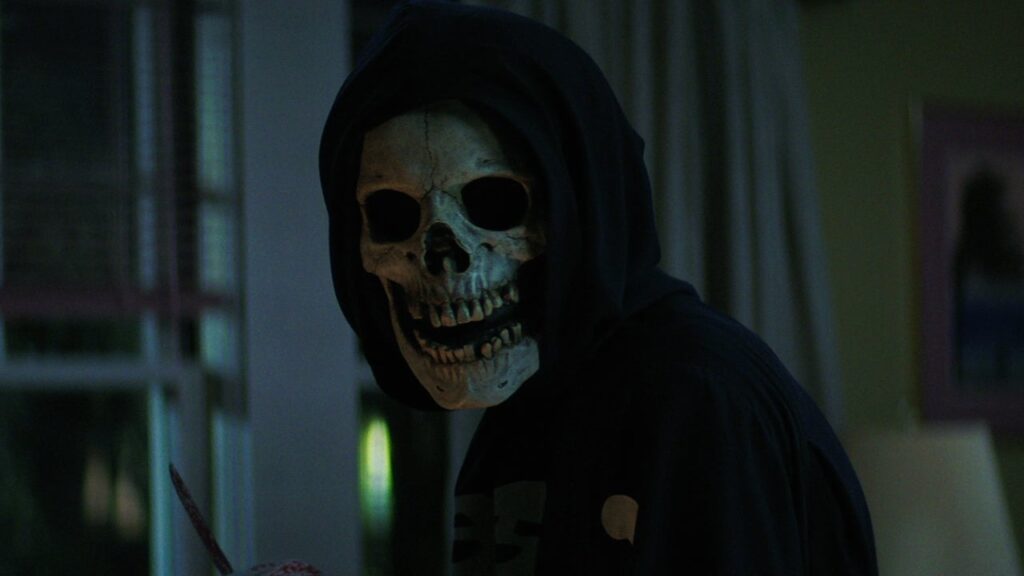
We’ve got ourselves a Shay Hatten script today.
Hatten is known for his big energetic writing voice, which he definitely brings to today’s pilot. Hatten, who is not shy about his desire to emulate his hero, Shane Black, gives us all sorts of 4th-wall breaking action to digest in (Future) Cult Classic.
“If this scene doesn’t make every single person watching it vomit, I quit. Andy’s Dad’s guts have been, like, forking splorked all over the Goddamn place.”
Since I know some of you hate that writing style, tread carefully going forward.
The year is 2025 or 2030 — somewhere in that range – and 17 year old cool rebellious girl, Bree, is heading to her best friend, Andy’s, place so they can go to the first day of school together. The two are besties times a thousand, although you kind of get the impression Andy loves Bree.
Needless to say, he’s not happy that Super Cool Guy, Henry, has lowered himself from his cool guy pedestal to date Bree. We know this wasn’t easy because the social credit app the teens use has lowered Henry’s popularity out of the top 1%. Meanwhile, Bree and Andy are the two lowest-ranked students on the app, on purpose. They do bad things to stay at the bottom.
After a few oddly injected “Trump is evil” remarks that didn’t have anything to do with the story, all the students put on their virtual reality goggles, where they’re then transferred into a virtual environment, where their principal makes several announcements about the coming school year.
After this VR excursion ends, the principal tells everyone to meet him in the auditorium as he just received some devastating news (I can’t emphasize how clumsy this is – after the principal greets them in the VR world, he then says he wants to greet them in the real world, creating two scenes in what easily could’ve been one!). The principal then announces that one of the students (who we met earlier at a party) has been killed.
What we eventually learn is that some masked killer is running around killing people. It’ll be up to Bree and her friends to figure out who it is. Of course, they’ll also be hoping it isn’t one of them.
I’ve seen some bad ideas before. But this is up there.
A horror slasher story set in the future with the unofficial tone inspiration being Back to The Future 2. Who needs a regular horror show when you can integrate virtual reality, social credit apps, and hoverboards?
I’m sorry but horror and the future don’t mix.
Let’s not forget the last horror movie that tried to be futuristic. Demonic? Remember that masterpiece? There were a confirmed 13 deaths from the 100 people who went to see that movie in theaters. Cause of death? Boredom.
Horror is the one genre that gets better the further back in time you go. If you go back just 30 years, we couldn’t call anybody when we were in trouble. We just had to deal with it. That alone makes for horror situations that are a thousand times scarier.
I just watched Silence of the Lambs again (yes, for my dialogue book, in case you were wondering) and I was thinking that great scene where Clarice accidentally visits Buffalo Bill’s house couldn’t have been written today. Her boss would’ve called her to warn her. And, if she didn’t answer, he would’ve texted, which she would’ve checked.
But things get really scary if you go back 50 years, 100 years, 150 years. In those days, not only was everything spookier, but you were really on your own if you were stuck in a bad situation.
The badness of this pilot didn’t stop there, though.
It’s set 15 years in the future and we would occasionally flash back eight years to when Bree was a kid. So now we’re flashing back despite the fact that this show’s flashback is still our present’s flash-forward. It’s just weird. It twists your mind in all the wrong ways. You’re thinking about things that have nothing to do with the story itself, which means the suspension of disbelief is constantly being broken.
Shay was probably frustrated because he was trying something different here. And isn’t that what we’re told to do as writers? Be unique. Show a new voice. Find a different angle. Be subversive.
Then we do all those things and everyone’s like, ‘well that was dumb’ so we shrivel up into a ball and spend three weeks eating 5 dollar donuts from Slider’s even though they make your tummy hurt cause all the yeast is natural and therefore expands way further than all that fake yeast and you promise yourself you will never ever try something original or eat donuts again. You’re going to play by the rules from now on.
Look, I’m not telling you to play it safe.
But “different” is a dicier path. It has a much higher failure rate. That’s because if something hasn’t been tried already, it’s not because you’re the one genius who came up with the idea. It’s more likely because it’s been tried before and failed badly, so everyone forgot about it.
This begs the question, how does a writer recognize that they have a bad idea?
Well, the best way to find out is to poll the idea with people who have no connection to you. Put your idea here in the comments and see what commenters say. Don’t listen to the commenters who are your friends as they will likely be nice to you. Look at the people who you have no connection to. They’re going to be the most honest.
If the ratio of dislike to like is around 5 to 1, you’ve got a bad idea on your hands. Anything worse, you’ve got a really bad idea on your hands. You want to be closer to the 4 likes for every 1 dislike ratio.
But let’s say you’re private about your ideas and don’t want to post them on the internet. What then? If you truly want to figure it out privately, you need to be extremely honest with yourself. Start by asking, is writing this script like pulling teeth? Does every scene and moment feel forced? Do you dread writing the script because it’s always difficult to come up with pages?
Deep down, do you have this constant feeling that the story doesn’t work?
If so, you probably have a bad idea. I’m not going to go so far as to say this is true all the time. Some genius works are hard to write. But I think we all know, deep down inside, if something is working or not. And if you’re unsure, you always have me. You can get a consultation and I’ll tell you straight up, if you genuinely want to know, whether the idea works or not. You can even get a logline consult done BEFORE you write the script to potentially save yourself a lot of time.
Also keep in mind that you can pivot. You don’t have to completely abandon a script if you love the idea. Sometimes it’s a matter of changing the main character POV. Sometimes it’s about changing genres (from a slasher to a mystery, or a drama to a horror). Sometimes you haven’t unlocked the best angle to tell the story from yet.
When it comes to today’s story, it does start to come together a teensy bit towards the back end of the pilot. Once we start looking into Emily’s murder, there is a slightly fresh perspective we’re exploring this genre from – this idea that a murder has been committed in a world where murder has basically been eradicated.
But, again, the tone is so off here. The comedy and the horror don’t mix organically. You throw in the “Back to the Future 2” future speculation stuff (“Zoinks! There’s one of them hoverboarders!”) and it gets even jankier. The story just doesn’t know what it is.
And I could totally see this playing out when they tried to shoot the thing. I could see five actors playing five different tones. That’s how poorly constructed this mushy mythology is.
I struggled through this one from the get-go. I’m surprised I was able to make it through the whole thing, to be honest. It was that bad.
Script link: (Future) Cult Classic
[x] What the hell did I just read?
[ ] wasn’t for me
[ ] worth the read
[ ] impressive
[ ] genius
What I learned: When it comes to comedy-horror, the comedy has to be organically built into the story. That’s why yesterday’s comedy-horror film, Deadstream, was so good. The main character was an annoying Youtuber. So that’s where all the comedy came from – him being one of those annoying Youtube personalities. When you’re just trying to add comedy to add it, cause you want to, you get today’s pilot. Everything feels forced.
OFFICER KIPPER
Peyton, the boyfriend. It’s his SnapStream feed.
MOSCOVITZ
Is that like SnapChat?
Kipper stifles a laugh. Moscovitz glares at him.
OFFICER KIPPER
Sorry, just– SnapChat was over ten years ago. This is totally different.
Ooph. This is what passes for humor in this script. Forced humor is the worst humor.
What I learned 2: Unless you have an amazing horror idea that needs to be set in the present, I highly suggest you set you horror script at some point in the past.

It’s always fun to see Scriptshadow veterans have success. Kevin Bachar is a former Amateur Showdown winner. He credits the win and the subsequent review as a big learning experience for him. Since then, he’s gone on to write a script, The Inhabitant, a modern take on serial killer Lizzie Borden, that he got optioned and eventually made. The movie is out right now (!!!), both in theaters and on VOD. Kevin is a documentary filmmaker who grew up in Queens and attended Brooklyn College.
SS: How many scripts did you write before something happened with this one?
KB: The first script I wrote was a horror film entitled – The Peak of Fear – which I submitted to Amateur Showdown, way back in 2014. Although it won, it didn’t get the coveted “worth the read” Script Shadow seal of approval. But it was a great exercise in getting notes and applying the ones I thought worked and discarding those that didn’t. The Inhabitant, which was originally titled – Blood Relative – was my third script. It was also a conscious decision on my part to write something easy to produce and relatively low budget. I know we’re told all the time not to chase after genres and we should write what you “love”, but the truth is no studio or producer is really reading scripts from unknown writers for big budget pics. The best way into the industry is through horror/thriller with a hook or twist. Mine was the attachment of the Lizzie Borden myth set in modern times.
SS: I know you are a big reader of the site. Can you point to anything you learned on the site in particular that helped you with this particular script?
KB: I’m an avid reader, and have been since I started screenwriting. I remember one bit of advice you gave in regard to plot, where you used the metaphor of blowing up a balloon. The script should be continually blowing up that balloon until it keeps getting bigger and bigger until you know it’s going to explode, but you keep blowing, getting it to the absolute stretching point, and then you’re wondering how many more puffs can it take until you bellow out one more breath and then – BOOM.
SS: When did you finish the script?
KB: I finished the script in 2015 and placed it up on the BlackList website. It ended up getting a number of the coveted 8s and was eventually highlighted as a featured script on the site. Just to be clear, this is the BlackList website, not the annual list that comes out and you review scripts from.
SS: How did you get your manager (or agent, or both)? And did that happen with this script or a previous one? If a previous one, how many scripts ago and what was the script about?
KB: The manager that first helped get The Inhabitant (Blood Relative) rolling, found me via the BlackList website. They read a number of my loglines for scripts I had on the site and they thought they were very producible. I think it hits something you mention all the time about the importantance of loglines and is your idea a movie. Not to be a downer but too many times I’m reading loglines or ideas mentioned on Script Shadow and they are too naval-gazing inward dramas or high-flying space operas that aren’t going to get serious attention from any manager/agent.
SS: Why do you think it was this particular script that got made (as opposed to your previous scripts)?
KB: My previous script, the aforementioned – Peak of Fear, was horror, but was not what you’d consider low budget. It wasn’t in any means a high-budget but it wasn’t going to be less than 2 million. The Inhabitant was not special efx heavy and could be done at a lower price point. It also had a teenage lead which is one of the key selling points for horror – since that’s the biggest audience for the genre.
SS: When was the script purchased/optioned?
KB: The script was eventually optioned in 2019. So, I wrote it in 2015 but it didn’t get optioned until 4 years later. I can’t stress enough that you have to be willing to play the long game in screenwriting.
SS: When and how did the money come through?
KB: The option money came through when the option was signed and then the payment for the full script came in when we began principal photography. I know everyone wants to know numbers but that’s not going to happen, sorry but as they say – That’s personal. And to be honest it has no bearing on breaking in and what you might get paid for your work. It all depends on the budget, studio, producers and where you shoot it.
SS: A lot of scripts get written. Rarely does a script get made. What would you say was the most important factor in this script getting made? Who, involved in the process, was the most important person in getting the movie made?
KB: I think there are a few key players who helped get The Inhabitant made. The manager I mentioned earlier also managed a director who loved the script. I worked with the director and created mood boards and a proof-of-concept trailer or a rip-o-matic (see the one Rian Johnson did for Looper.) The director eventually dropped out, but it helped make the project real. The producer of The Inhabitant, Leone Marucci, was the next huge driving force, as any producer is to get a film made. It’s kind of obvious, but the film doesn’t get made without Leone pushing it forward because he believed in it. He actually contacted me about another script which was under option and I told him about The Inhabitant, and that it was available. He read it and loved it. Which brings me to the final most important factor/person to get the film made – the screenwriter. I was always pushing it forward and committed to spending time and money to get it made. On my own dime I flew out to Los Angeles to take meetings with the director and Leone (pre-covid 2019) which showed that I was serious about the film. I also spent time and money creating and cutting the proof-of-concept and mood boards which were really helpful in getting people to understand what the film could be.
SS: I believe this started as an independent project right? Can you explain to me how it ended up at Lionsgate?
KB: It was an independent production, but when the film was finished it was then taken to various studios – big to mid – and both Lionsgate and Gravitas Ventures partnered in the release.
SS: I noticed you’ve had a long and successful career as a documentary filmmaker. I suspect some writers might think you had an advantage being in the industry already. Possibly gaining industry contacts from that world. Did your career in the documentary world help you succeed in screenwriting at all?
KB: The truth is my doc career meant nothing to the fiction/movie world. It gave me an interesting story at meetings but not one of my documentary connections at Discovery, Nat Geo, etc intersected with the feature world. I let people know this all the time because they want to put up these invisible fake walls and in the end it comes down to their writing. My doc work didn’t help me win the Page Awards, twice semi at Austin, win Final Draft Big Break for romcom and win Screencraft’s Action/Thriller contest which had Steve de Souza, the writer of Die Hard, as one of the judges. If you write a great script and get it out there through Script Shadow or contests or queries then it will get read and that’s the truth. Sorry if I’m ranting, it’s just I’m so tired of hearing the same old “woe is me” lines. Just write, and write great scripts.
SS: With everything you’ve learned, what would be the biggest advice you’d give to writers on how to write a script and get it made into a movie?
KB: I think you need to read what is getting made and ask yourself a simple question – “Is my writing this great?”. Go read Taylor Sheridan’s Wind River – does your script sound like that? Move like that? Draw you through the page and onto the next? Read any movie that got made over the last 20 or so years and compare your writing to theirs. I know when I started my writing was nowhere near what was being produced. But I’m a perfect example that you can get better, much better.
SS: I tell writers to do this as well but I’ve found that, often times, writers just aren’t able to see how professional writing is better than theirs. Most writers I encounter, actually, think their writing is better than the movies getting made. So is there a more specific way to judge your writing against professional writing?
KB: To be a writer, a writer who will sell that novel, short story or screenplay, you have to be able to be 100% subjective on your own writing. I think this might be one thing that can’t be taught. You see it a lot of times on Script Shadow when people start endlessly defending their script when people start to give criticisms. They’re never going to improve. I also think, having a real objective sounding board is key. Having your friends or family read it means nothing and really offers you no real feedback. Even a friend who’s a reader or producer, because in the end they’ll never give you their real reaction if the script isn’t good. Also, I know it’s controversial but screenwriting competitions/fellowships can offer you a real benchmark for your script. The Inhabitant – as mentioned, received numerous 8s on the BlackList, it was semi-finalist at Austin, a top %15 at Nicholls amongst other placements. Also, winning Amateur Showdown on Script Shadow years previous told me that I had some talent as a writer. Too many writers never get their work out there to see if it in fact is professional level.
Now go and watch The Inhabitant!
$$$ – SUPER DEAL ON SCRIPT NOTES! – $$$ – I’m letting TWO MORE people in on that newsletter deal. 4 pages of notes on your script for just $299. That’s 200 dollars off my regular rate. E-mail me at carsonreeves1@gmail.com with the subject line, “DEAL,” and you’ll be first in line to reserve a slot. If you’ve got a TV pilot, I can take another 50 bucks off the price. Take advantage of this! You never how long it will be before the next deal!
Genre: Romantic Comedy
Premise: With the future of Manhattan’s Chinatown at stake, a stubborn store clerk battles against an innovative CEO’s expansion plan, while both are unaware they’ve been falling in love with each other on a new, anonymous dating app.
About: This script finished on last year’s Black List. William Yu has written a couple of short films, one of which he directed.
Writer: William Yu
Details: 117 pages (!!)
 I don’t know who this is but she should star in this movie
I don’t know who this is but she should star in this movie
*****WE INTERRUPT THIS REGULARLY SCHEDULED PROGRAM*****
With White Lotus doing so well at the Emmys, I wanted to remind you of the ENTIRE WEEK I once took to praise this amaaaaaaaazing series. Here ya go!!!
Day 1
Day 2
Day 3
Day 4
Day 5
*****NOW BACK TO TODAY’S REVIEW****
As we continue this theme of ‘what makes good dialogue’ that I will loosely continue over the next few weeks in the lead up to the Scriptshadow Dialogue Book, I thought it’d fun to review a romantic comedy, a genre that is designed to showcase dialogue. I figured, good or bad, we could learn a thing or two about dialogue today. So let’s jump to it!
We’re in Chinatown, New York City. Sophia Chao is so focused on her “WeWork” like startup company that she hasn’t had a lot of success dating. Hence, she says “screw you guys, I’m outta here” (no, she didn’t really say this) and focuses on convincing three elderly store owners to sell to her so she can start building her “OpenSpace” headquarters.
The grandson of one of these owners is Brandon Wong. Brandon is Chinese-American and very adamant that big corporations are bad! Very bad! He spends a lot of time protesting and protecting the traditions of his hometown. When he learns that Sophia is trying to build a company on his street, he takes his protesting to the next level.
Now since both characters are sick of the dating scene, they start using a new anonymous dating app. No pictures. Just an algorithm that matches you up. In case you were wondering, Brandon and Sophia match and start chatting on the app. They don’t want to go on dates. They just want to chat on the app. And start falling for each other.
Then Brandon gets some bad news. His grandma actually wants to sell the store and move to Florida! If she does this, Big Bad Sophia will win and Brandon can’t have that. So Brandon makes his grandma promise to give him the summer to drum up business and start making some real money for the store. She reluctantly agrees and Brandon is off to the races, all while occasionally bumping into Sophia and having no idea she’s his online girlfriend.
Let me start off by saying the hoops we have to jump through to buy into this story are so high, they require the latest Air Jordans to reach. The writer needed a way to have these two date each other without knowing who the other was, so he set up an anonymous dating app with no pictures and then, even after they start dating, they don’t want to see each other, which, of course, is necessary, since the second they see each other, the plot doesn’t work anymore. It pummels the suspension of disbelief into submission.
I will say that I liked the choice to make the guy the local business owner and the girl the big mean CEO. That was different from what I’m used to seeing. But outside of that, I struggled to find things to celebrate here.
Let’s get to the dialogue cause that’s our focus these days. Here’s any early exchange where Brandon and Francis meet at a protest and debate the challenges of dating in the modern era. Brandon doesn’t do a lot of dating, which Francis takes exception with.
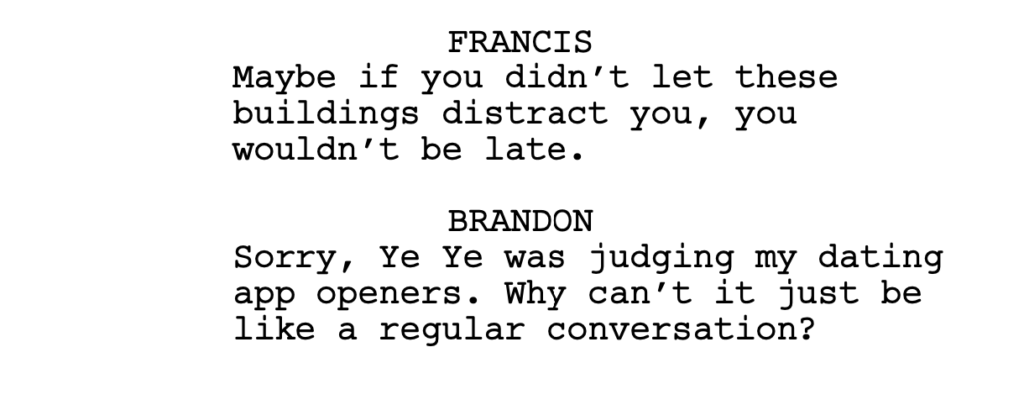
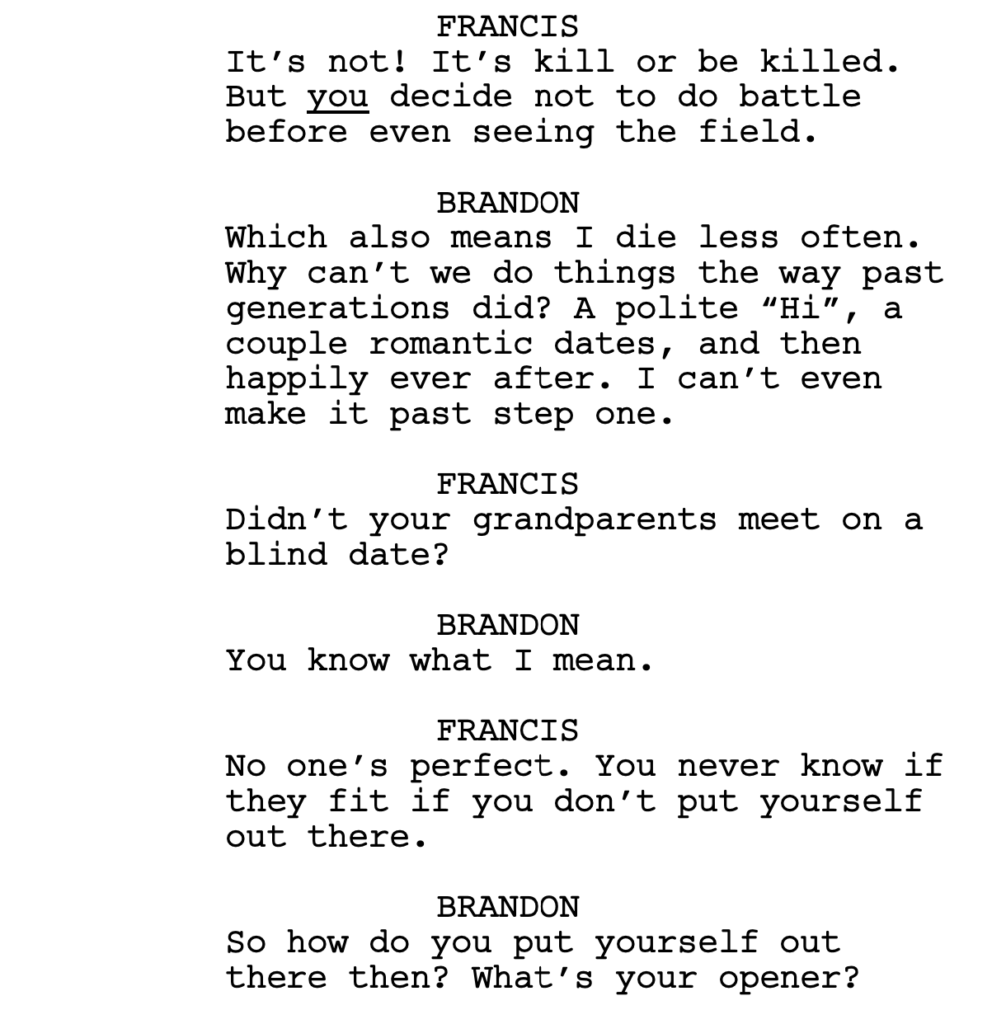
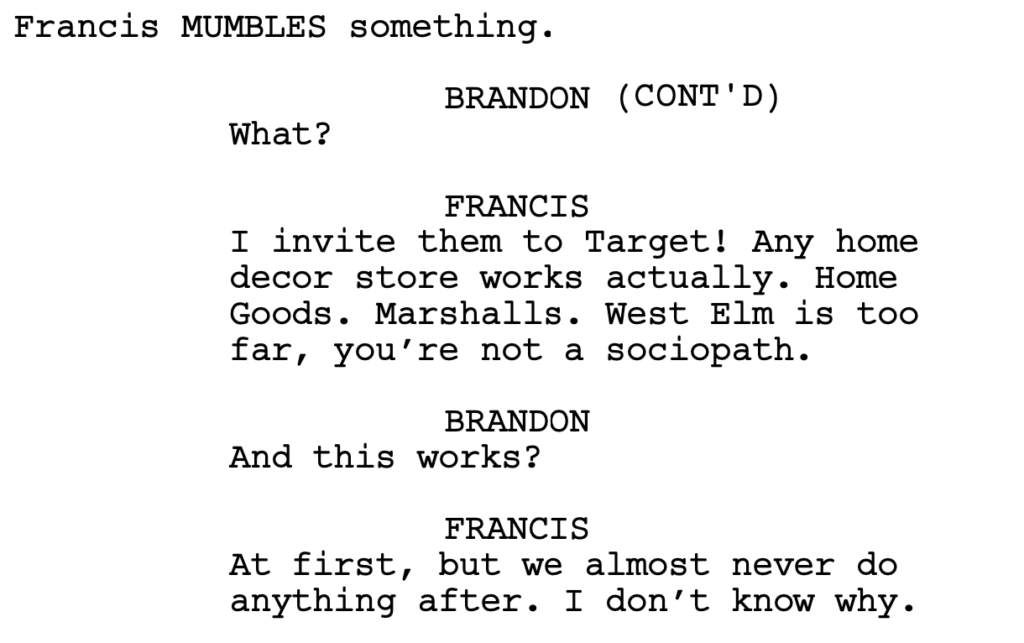
Okay so we start out with an analogy. And in my dialogue studies, I’ve realized that analogies can be a big asset in sprucing up dialogue. Everyone likes a good analogy. But here’s the rub. It’s gotta be a good one. And this one is okay, I guess. Comparing dating to war is something I’ve heard before so it’s not exactly a fresh take on the topic, which you would prefer your analogy to be. But it’s an okay start.
From there, we cover a little backstory. We introduce some character information, as we’re learning about Brandon’s dating past. But then we run into, “No one’s perfect.” This is such a boring common phrase that it generic-izes the conversation. When characters say generic things, we start seeing the dialogue as generic.
Even though I didn’t love the war stuff, the writer probably should’ve continued on with that analogy. Keep using the war stuff to explain their thoughts and ideas about dating. You introduced it. You might as well keep using it.
We then come to Francis’s strategy on dating. Francis is clearly the comedic relief in the film. For that reason, you need him to be funny. I know that sounds obvious but what I mean is: chuckle-worthy isn’t enough. He has to be legitimately funny. And here, he uses this Target line, which I like in that it’s SPECIFIC. He didn’t say something generic like, “I just give’m a taste of that Francis charm.”
But the joke has to have some logical setup and payoff to it that we understand and therefore laugh at. I’m not sure this has that. I suppose it’s kind of funny that he takes them to these random places. But then we get the line, “West Elm is too far, you’re not a sociopath.” Assuming we’re on board with the running home decor joke, what does one of these places being too far away have to do with being a sociopath?
It’s that “bridge too far” thing that we all struggle with as writers. The joke makes sense in our head because we can see the 5 other dots we’ve connected to get to the punchline. The reader can’t see those other dots, though. They see the first (home decor date) and the last (sociopath for stores that are too far away) and can’t make the connection.
Now you have to understand, the script I read right before this – for my dialogue book – was the Fleabag pilot. And Waller-Bridge’s jokes are so light-years ahead of everything that it was a bit like listening to Chopin and then Justin Bieber. I mean look at the difference here…
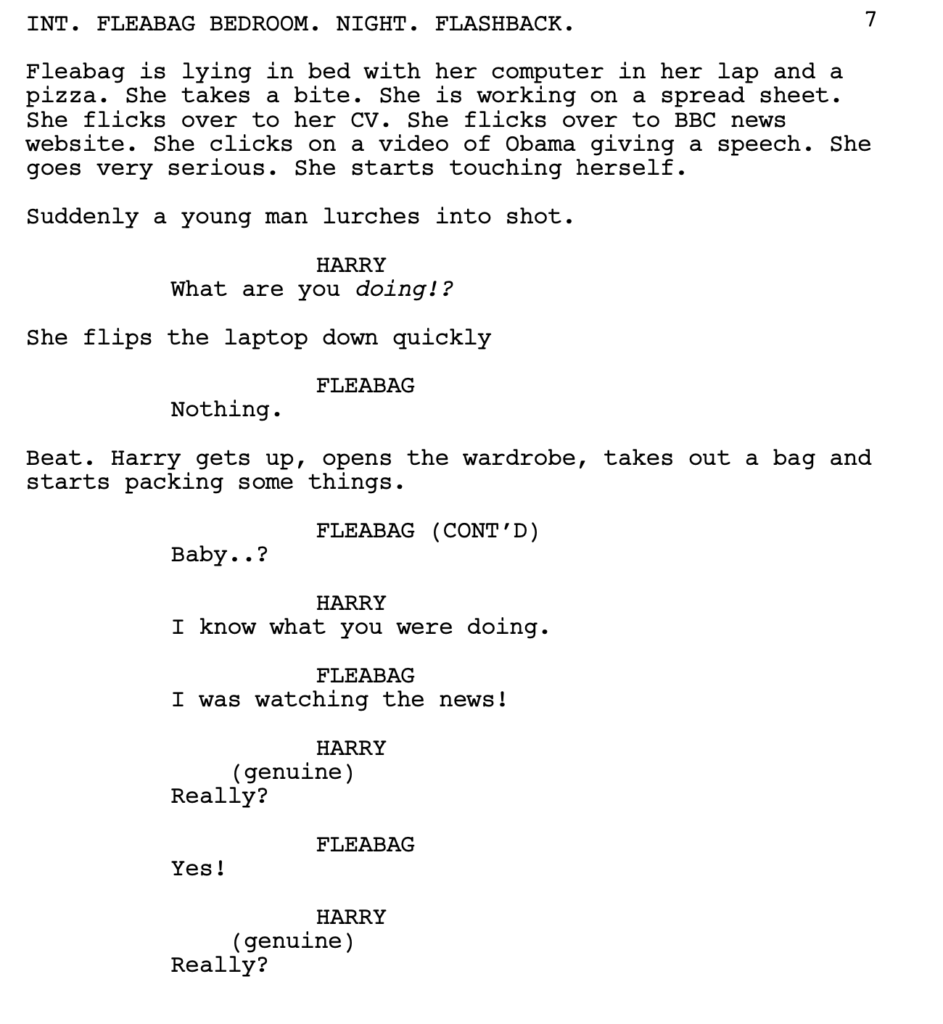
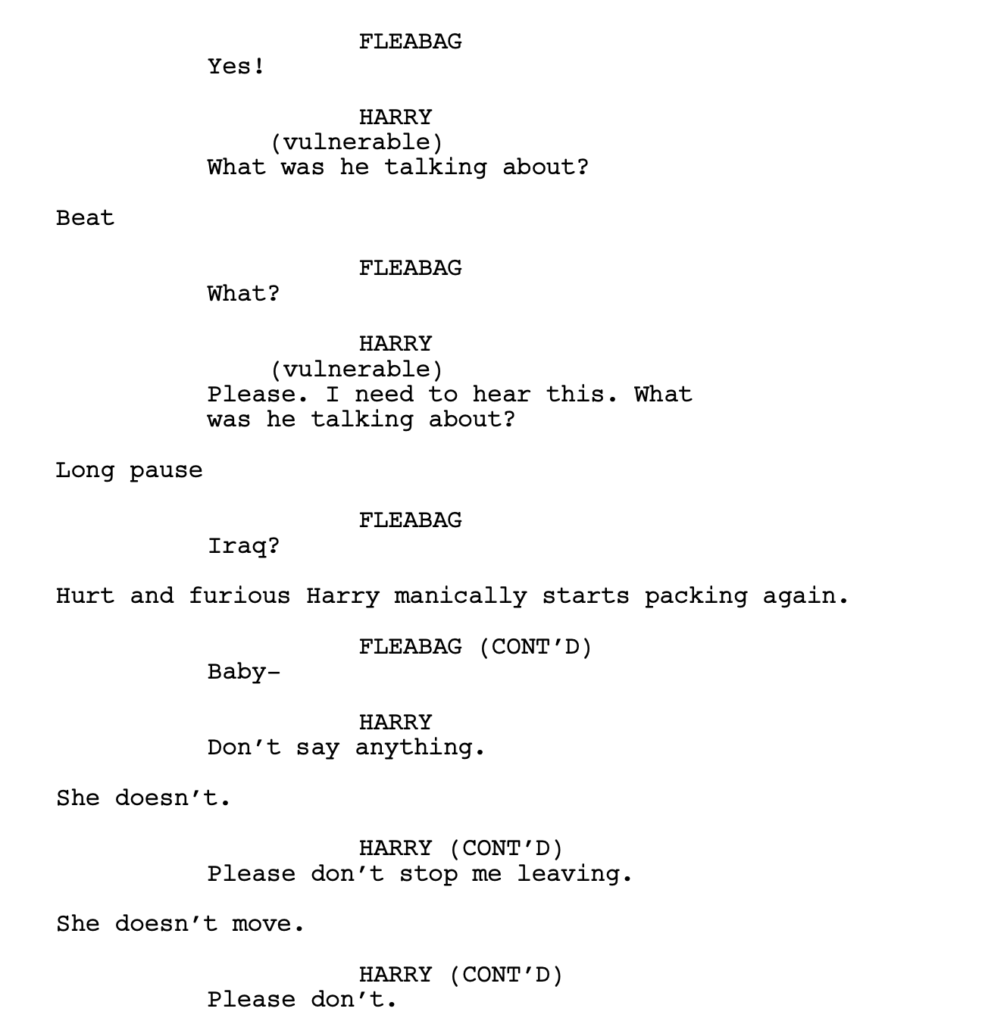
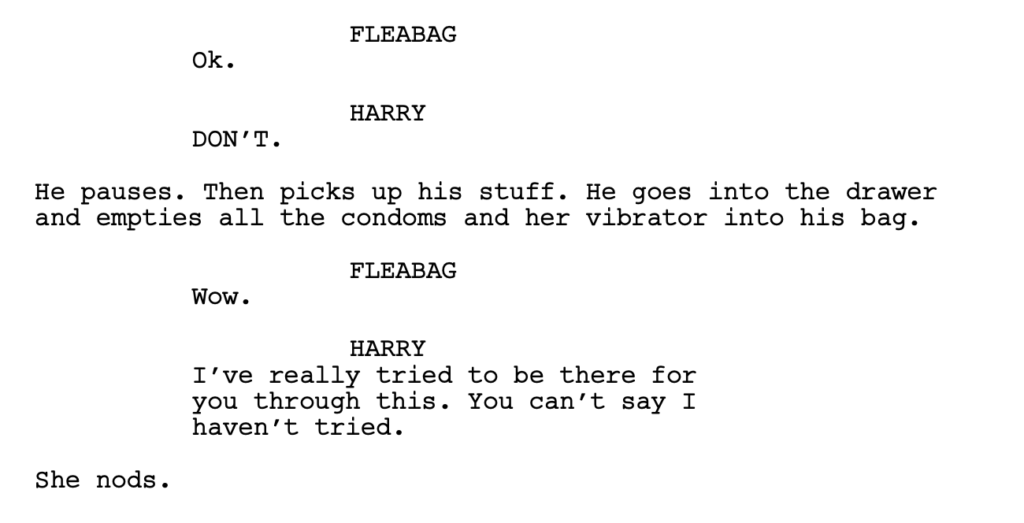
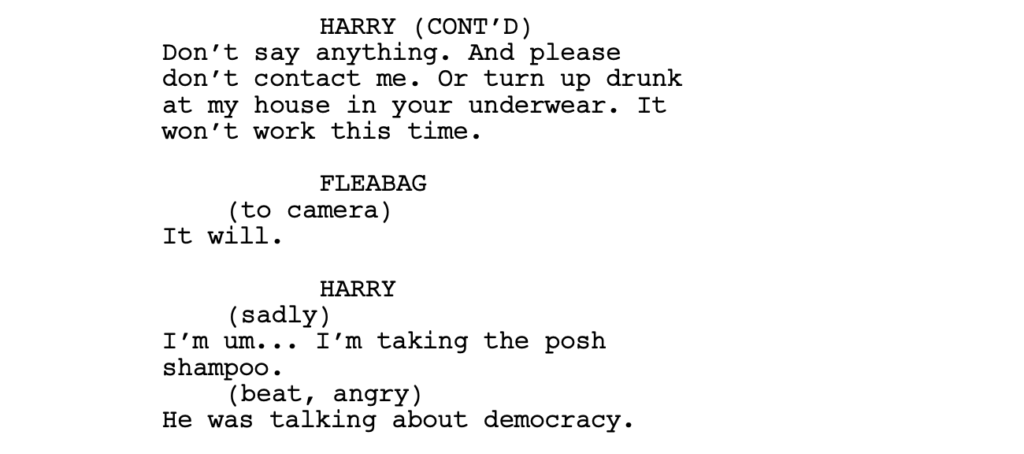
The scenario itself is so much more clever and unique. Who starts masturbating to a political figure’s speech? But it wasn’t just that. The boyfriend’s reaction clearly informs us that this has been an ongoing problem, which makes the interaction even funnier. And then we watch as she desperately squirms to try and save herself, which is always fun to watch. All of this is made even funnier by the fact that the previous scene has her meeting a guy, the guy asking if she has a boyfriend, and when she tells him, no, they just broke up, the guy assumes that the guy is the one who screwed it up. We then immediately cut to the above scene.
Anyway, getting back to It Was You.
The last line is Brandon asking Francis if his dating strategy works and Francis saying, “No it doesn’t, and I don’t know why.” An obvious punchline like this isn’t very funny because it’s not at all surprising. Francis informing us that a lousy dating tactic has lousy results is… expected, right? So where’s the joke? It would’ve been funnier if he’d told us that a lousy dating strategy actually worked great! So a line like, “Believe it or not, my success rate is about 80%.” Cause we’re not expecting that.
This is what’s hard about writing dialogue. We all think different stuff is good. We all think different stuff is funny. But one of my simplest criteria for objectively analyzing dialogue is, “Could this scene have been conceived of and written in ten minutes?” If so, the writer isn’t doing enough. This scene definitely feels like that.
You have to get into the reader’s head and ask what they’re expecting from this dialogue and try to outsmart them or keep coming back to the scene and trying to one-up the jokes in it. “Is this the funniest line I can use here? Is there something better?” Every rewrite, keep trying to top yourself with the jokes.
So why was that Fleabag scene so unique? How can you pull that off as a writer? I suspect that one of Waller-Bridge’s friends shamefully admitted to her, on a night out drinking, that she masturbated to the Prime Minister on TV once. And Waller-Bridge took that idea and said, what if the Fleabag character not only did that, but it was an ongoing problem in her relationship?
That’s how you build the framework for original funny situations. The problem most writers make is that they’re drawing from movies that they’ve seen instead of real life. So they’re just rewriting scenes that have already been written, which is definitely what this scene from It Was You felt like.
Unfortunately, I’ve run out of time to judge the rest of the script but I think it’s safe to say that you can guess what happens. There are a few fun scenes when the two ignorantly run into each other in real life. But the script can never overcome the amount of buy-in it’s asking for. I just couldn’t get past the anonymous dating app thing. Name me one person in the world, who isn’t blind, that uses dating apps without pictures.
[ ] What the hell did I just read?
[x] wasn’t for me
[ ] worth the read
[ ] impressive
[ ] genius
What I learned: Every time you write a scene of dialogue, I want you to imagine that dialogue posted here, on this site, in the cold naked light of day. Would it hold up? Are you mentally making excuses for it? If so, time to rewrite that dialogue, baby.
Is Kevin Feige losing a handle on the quality of the MCU?
Genre: TV Show/Superhero
Premise: (from IMDB) Jennifer Walters navigates the complicated life of a single, 30-something attorney who also happens to be a green 6-foot-7-inch superpowered Hulk.
About: This series was created by Jessica Gao, which continues a recent Marvel trend of going with riskier and riskier showrunners. Up until this point, Gao’s biggest accomplishment was writing an episode of Rick and Morty. The show has had a strange press tour, with co-stars such as Jamella Jamil openly wondering, on social media, why her costume was so ugly. The show stars Orphan Black star Tatiana Maslany as the She-Hulk. The pilot was directed by Kat Coiro, who recently directed J. Lo in Marry Me.
Writer: Jessica Gao
Details: 35 minutes
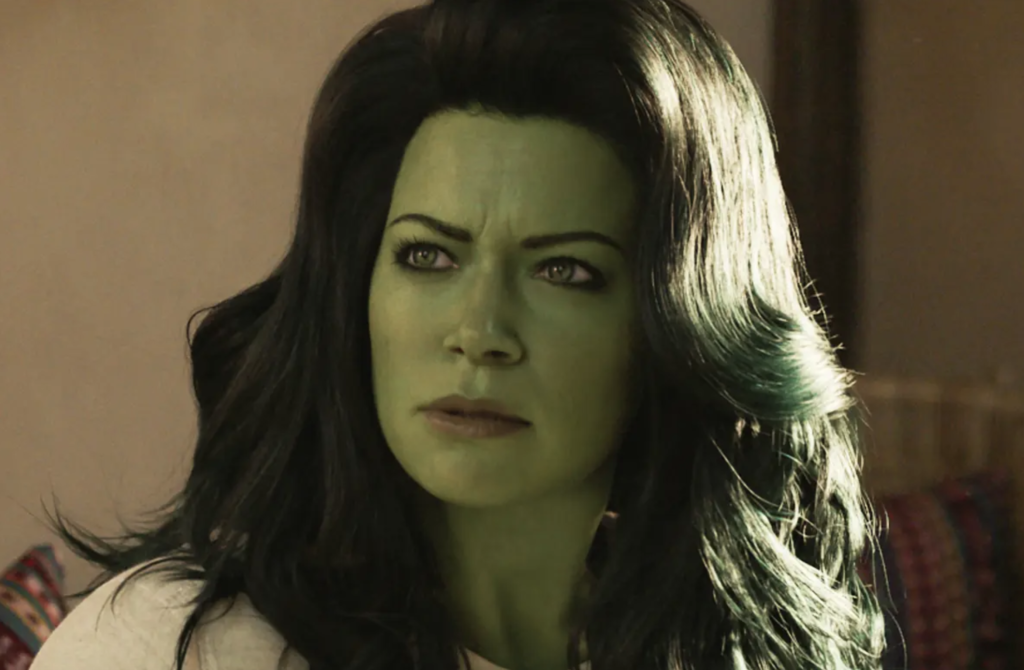
Marvel is implementing the same genius strategy Lucasfilm implemented in the 90s whereby they took their IP and laid it directly on top of already proven video game genres.
Side-scroller? Add Star Wars characters. RPG? Add Star Wars characters. First-Person Shooter? Add Star Wars characters.
Marvel realizes they can utilize this same strategy with their television shows. They have an endless number of TV genres they can lay their brand on top of. Sitcoms? Wandavision. High-school comedy? Ms. Marvel. Legal One-Hour Drama? She-Hulk.
It’s a clever strategy and I hope that, as they tighten the screws and perfect the formula, it will work for them.
Unfortunately, She-Hulk is going to be seen as one of the early test-cases that didn’t work. The reason for that is simple. It prioritizes message over story. And the thing about message-pushing TV is, even if you agree with the message, you still feel the manipulation, which breaks the suspension of disbelief, and prevents you from enjoying the experience.
We’ll get to that in a second. But first, here’s a quick breakdown of Episode 1. A young attorney named Jennifer Walters tells us (as she talks straight to the camera) that she’s an attorney but she wants to catch you up on how she got here.
This jumps us into a flashback where Jennifer is hanging out with her cousin, Bruce Banner (as in The Hulk), when they get in a car crash. During this crash, Bruce’s blood leaks onto an open wound of Jennifer’s, which means Jennifer can now turn into a Hulk too!
So Bruce whisks her away to his own private island where he spends the rest of the episode training her in the ways of Hulkness. When he explains that she’ll need to train for 10+ years before rejoining society, she freaks out and says she only needs one week. Hey, it worked for Luke Skywalker. Why not her? (note: I came up with this analogy, not the writer. The writer isn’t nearly that clever).
Her reason for *why* she only needs a week may have been the single most miscalculated line in the history of television. Which I’ll get to in a bit. But, anyway, we jump back to the present, where Jennifer is finishing up a case in the courtroom when a female villain bursts into the room, cliffhanging us until the next episode.

So I went and watched some interviews about this show and what I learned was that they originally wrote the season so the origin stuff – Jennifer becoming She-Hulk – wasn’t revealed until the final two episodes. When they test-screened it, everybody was confused. You had this big green woman walking into courtrooms without any explanation as to why.
So they hurriedly rewrote the first episode as the “origin story,” where we learn how Jennifer turned into She-Hulk.
It’s for this reason that the first episode is so problematic. It feels rushed from the start. For example, Jennifer and Bruce are driving their car in the mountains and, out of nowhere, a spaceship arrives, which distracts Jennifer enough that she crashes. This spaceship is never mentioned again. We have no idea who it was or why it was there.
The writers then make one of the classic “I’m a newbie screenwriter” mistakes where Jennifer keeps passing out as a cheap way to move her from location to location. She passes out after the crash, which allows us to jump to Bruce’s lab. She passes out again during one of Bruce’s tests, which allows us to jump to Bruce’s secret island.
People don’t routinely black out. So, when you’re doing that, the reader reels from your laziness. It feels like the writer isn’t even trying.
From there, we get the “fun and games” section where the Hulks play around with each other, tossing boulders into the atmosphere. It gets kind of fun, except that there’s this growing “men just don’t understand” subtext permeating the story. If Bruce is explaining something about being a Hulk, Jennifer sees it as “mansplaining.”
It’s mostly in a jokey way. But that’s when the show hits us with the line that’s now gone viral and which will be the nail in She-Hulk’s coffin. Because what the line says is, “This is a message show. We’re going to be propping up one gender over another. And if you don’t like that, buh-bye.” Which is their prerogative but it’s a fast way to lose half your audience. And why in the world would you want to do that?
*Ahem* 🗣 Say it louder for the people in the back 🗣 #SheHulk #TatianaMaslany pic.twitter.com/EWd57xbehr
— IMDb (@IMDb) August 18, 2022
Being this on-the-nose about ANYTHING isn’t going to work. There’s also such a generalization here from the character – painting gender with such a broad brush – that it makes her look ignorant. Which, in turn, makes us not like her.
One of my favorite movies from a couple of years ago was The Invisible Man. That movie was about the dangers of some men being toxic. And it never had a scene like this. Where the heroine spouts out on-the-nose dialogue about the state of the male gender. If ever there was an attacking line, it attacked the individual, her ex-husband. Not every person on the planet with a penis. Yet the movie gets its message across 1000x better than She-Hulk.
It’s frustrating because I like the actress here. And I like the idea of a superhero version of Ally McBeal (which is getting a sequel btw, BECAUSE of this show). But the second the show decided it wanted to be exclusive instead of inclusive, it was done. They may double-down with a series renewel out of spite for the blowback they’re getting. But mark my words, this series is toast.
Kevin Feige has to be careful because he’s starting to lose touch.
We just saw Top Gun pass Avengers Infinity War at the domestic box office. What is Top Gun known for other than being a really great movie?
ZERO MESSAGE!
All it cared about was entertaining. And audiences were like, “FINALLY! We don’t have to be preached to. For once!”
“Nope,” the biggest major release message film of the year, made 100 million less than the studio was hoping for.
They/Them is getting destroyed by the very critics who are so desperate to prop it up.
People are sick of the preaching. Yet She-Hulk is ready and willing to not only die on that hill, but become a martyr on it.
The thing is, there are ways to push messages and get the audience on your side. One way is to take the piss out of the preaching. When Jennifer says, “Men are toxic and the patriarchy is in charge and blah blah blah,” have Bruce say something like, “Okay, calm down there, Don Lemon.” Have more fun with it instead of slamming us over the head with a hammer, implying that if we don’t weep for Jennifer, we’re bad.
Unfortunately, even if this wasn’t an issue with She-Hulk, the writing isn’t strong enough to have saved it. We can see that right from the start. Jennifer turns to the camera and starts explaining things to the audience. This is fine. Breaking the 4th Wall has been done forever and is a legitimate creative option.
But then she refers to what she’s in as a “legal show.” In others, she goes beyond the fourth wall to the fifth wall. She’s not just talking directly to the audience. She’s telling you that this thing she’s a part of? She’s just an actor in it. They might as well have turned the camera to show the crew shooting the shot. That’s how little they care about creating an illusion.
It’s sloppy. It’s a cop-out. It gives them an excuse to be lazy cause now their hero can say stuff like, “Sorry for that lame scene! We didn’t have a lot of time to write it! Zoinks!”
Between that and the random spaceship and the blackouts and the over-the-top messaging – this is just a poorly written show. The only reason it seems halfway professional is because of all the money they spent on it. But from a writing perspective, it’s hackneyed and should be used as an argument to reestablish some quality control at the Marvel headquarters.
[x] What the hell did I just watch?
[ ] wasn’t for me
[ ] worth the stream
[ ] impressive
[ ] genius
What I learned: What a lot of writers don’t realize is that when you preach, you literally achieve the OPPOSITE of what you were trying to do. We see you’re trying to insert a message into our head, which makes us resist the message. Instead, sell your message through SHOWING as opposed to telling. By showing us just how psychotic and obsessed the ex-husband was in The Invisible Man, we received the deeper message about male toxicity invisibly.
